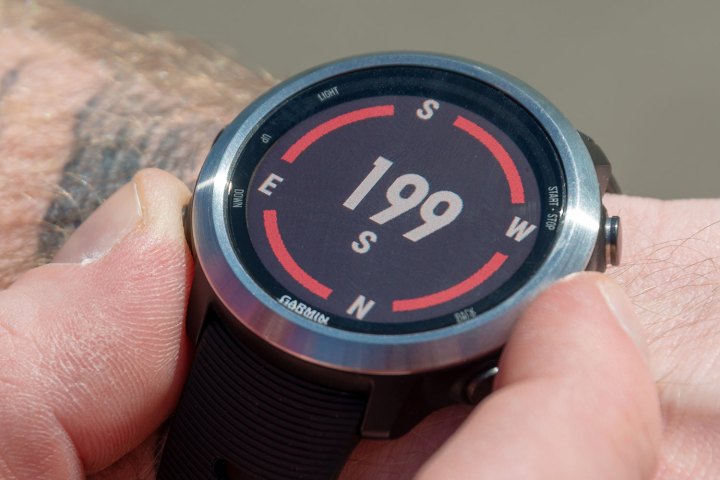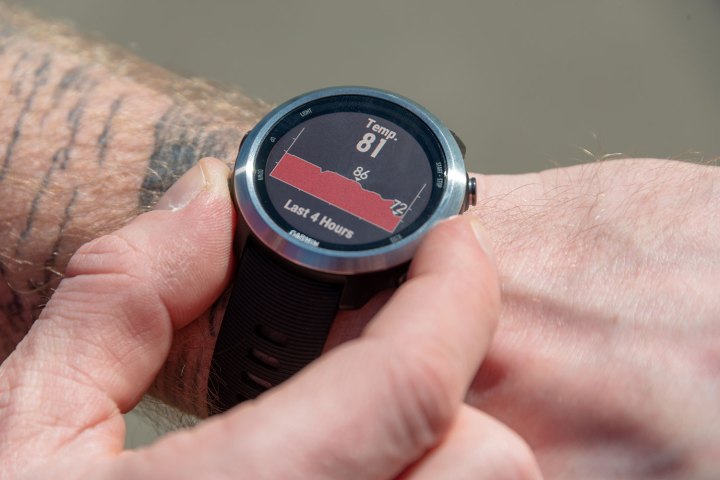- Offline music playback
- Extensive fitness tracking capabilities
- Doesn’t require a tethered smartphone for its full features
- 5- to 7-day battery life
- Expensive
- Buckle showed wear and tear after two weeks
If you own a fitness tracker, shouldn’t you be able to leave your phone behind when you work out? Yes, but many fitness trackers still need to be tethered to phones for features like GPS and music. Not this one. Garmin’s Forerunner 645 Music, is a lightweight yet powerful smartwatch designed to cut you free from a phone entirely.
Featuring built-in GPS, active heart-rate monitoring, contactless payments, and native music compatibility (a Garmin first), the Forerunner 645 Music looks every bit the part of a dynamic fitness tracker on paper. We decided to put the wearable through its paces to see just how well it performs in practice – and if it’s a true competitor to Fitbit and Apple.
What’s in the box?
Like most fitness trackers, Garmin’s Forerunner 645 Music comes packaged with only the wearable itself, a charging cable, and an instruction manual. With a partial charge, our watch took roughly 30 minutes to fully charge out of the box, and typically only required an hour to charge it up when it drained all the way.
A comfortable blend of function and style
With a stainless-steel bezel encasing a chemically strengthened glass crystal, the Forerunner has a classic look that remains sporty and tough. You probably wouldn’t wear it with a suit, but it’s classy enough to sport daily without concern. The watch is even compatible with a healthy selection of interchangeable, quick release bands, making it easy to swap for different colored silicone or leather bands, further increasing its versatility – the standard watch itself comes with either a black or red strap.
Upon putting the watch on for the first time, we were immediately pleased with how comfortable and lightweight it felt on our wrist. At just under one and a half ounces, the Forerunner weighs less than even the lightest Apple Watch. When we worked up a sweat during a workout in the gym or while riding our bike, it never became uncomfortable or cumbersome.
With plenty of notches running nearly the entire length of the strap, even someone with a small wrist wouldn’t have a hard time finding a good fit, and its 1.2-inch diameter watch face is just large enough for big or small wrists. The clear 240-by-240-pixel display is easy to read with or without the built-in backlight – though you’ll want it at night or in dark rooms.
We were immediately pleased with how comfortable and light it felt on our wrist.
While both Fitbit and Apple have embraced touchscreens, Garmin sticks with five tried and true buttons on the Forerunner. Start/Stop and Back are located on the right side of the watch face while Light, Up, and Down are located on the left. Though the names are self-explanatory, a few carry secondary shortcuts, as well.
For instance, holding the Light button down longer than a simple press brings up a quick menu giving access to features such as Do Not Disturb, the Garmin Wallet, a stopwatch and timer, the Find My Phone feature, and the watch’s digital power switch. Holding the Up key brings up a quick menu where you can change the watch face and alarm clock, or sync Bluetooth headphones. Holding Down activates the built-in music player.
Unlike the Samsung Gear Fit2 Pro or Fitbit’s Ionic and Blaze, the Forerunner 645 Music doesn’t require an extremely tight fit to actively register heart rate. Even when we set it comfortably loose, it still appeared to log an accurate heart-rate reading.
Packed with sensors
With GPS and its Russian cousin GLONASS, a real-time compass, gyroscope, accelerometer, thermometer, barometric altimeter, and the Garmin Elevate wrist heart-rate monitor, there’s not a lot the Forerunner 645 Music watch can’t do. Many of these sensors are standard at this point, but the quickly accessible compass and thermometer both stand out. Readings from the latter seemed a bit wonky at times, though, likely from cinching it a bit too tight.

While many current fitness trackers and smartwatches feature similar sets of sensors, the Forerunner proved they could be useful during testing. We always knew how close to our daily step count or workout goals we were, what our resting heart rate was between sets at the gym, and whether or not we were maintaining an 8-minute mile while running. It didn’t matter if we were running or biking, spending time at the gym, or even just sitting at our desk for work, it continued to offer dynamic feedback that kept us invested in our fitness plan. From monitoring our suggested resting periods between workouts to prodding us to up our weekly run mileage, we never felt as though we were just throwing fitness data into a void.
Comprehensive smart features
Modern smartwatches try to cram in as many features as possible — and Garmin’s Forerunner 645 Music is no different. In addition to the bevy of fitness features, it provides text message notifications, calendar access, weather information, and – its claim to fame – music storage. You can even pair it with one of Garmin’s Virb action cameras and use it as an on-wrist remote.
All these features are shockingly easy to access with just a few pushes of the up and down buttons. After setting up the watch for the first time, we found we could tap them to scroll through a quick snapshot of our heart rate over the last four hours, how our weekly fitness goals were looking, our daily steps, stored music, our daily calendar, text message notifications, as well as a compass and thermometer.
Fit for an active lifestyle
Garmin has been making fitness trackers since before the days of the iPhone, and it shows up in all the little details. For instance, while cycling or running, the watch’s built-in GPS knew when we stopped moving and automatically paused, so that it didn’t mess up average speed readings. If you pause for longer, it will automatically show your heart rate as you stand huffing on the side of the road.
This watch is a runner’s dream. You get the usual speed and distance, but also stride length, cadence, vertical ratio, ground contact time, and balance.
This watch is a runner’s dream. You get the usual speed and distance, but also stride length, cadence, vertical ratio, ground contact time, and balance. All those numbers could be overwhelming, but the Garmin Connect app helps make sense of them. It will log and store each run, send out training status updates that automatically compare workouts, and even inform you whether you’re overworking yourself, or training effectively. At the conclusion of each workout, it spits out quick readings on the aerobic and anaerobic effects, as well as how must rest is recommended before training again.
A new strength-training feature lets gym rats get in on the tracking, too, if they’re willing to invest the effort. We admittedly had a hard time remembering to start and stop the rep counter. The watch also has a hard time tracking some specific arm movements, and probably hit about 80 percent accuracy for us. You can manually input rep counts and weight if you want perfect precision. We essentially used it to keep track of our average and maximum heart rate, the amount of active and rest time we accrued, calories burned, and total number of reps.

In the pool, it’s capable of actively tracking laps, distance, stroke count, and lap pace. Like with bike rides and runs, the Connect app offers a more in-depth view to see larger trends. Garmin rates the Forerunner 645 as waterproof to 50 meters, and we never encountered any hiccups with it after getting out of the pool.
Pump up the jams
Onboard music means the days of toting along a smartphone for a workout or run is a thing of the past. You can listen through downloaded apps (currently only iHeart Radio is available) or upload songs directly through the Garmin Express desktop app, if you still have an MP3 collection. It only takes a matter of seconds to upload an album’s worth of music, and the watch has room for 500 songs. That’s enough to work out several times a week before hearing the same song twice, and playlists let you curate your own workout jams. It even supports native syncing of Bluetooth headphones – though it’s a feature that seems obvious, its execution is seamless. Between built-in GPS and built-in music, there’s simply no need to drag a phone along anymore.
Garmin Connect
Though the Forerunner 645 Music amasses loads of data, the Garmin Connect app is what makes it useful. The home screen offers quick glances at current heart rate, steps taken, number of intense minutes logged that day, stress levels, and calories burned. Expanding on any of these sections offers a more detailed look at the data, even allowing for it to be compared over hours, days, weeks, or months.
To take the experience even further, the app also offers a Challenge tab, which allows you to create weekly step challenges with any friends, a calendar function that neatly organizes your daily activity and workouts, as well as a News Feed that allows you to connect with friends and compare activity data.
Nearly a week’s worth of battery life
Over the course of our three weeks with the device, we only stuck in on the charger four or five times. It routinely showed strong battery life, even when we opted to use its fitness-tracking functions, active GPS, and music playback. Garmins claims it offers seven-day battery life when used as a smartwatch, or five days with music and GPS active, and we found those estimates to be spot on. Considering there are so many devices which require daily charging, it was refreshing to not have to find yet another outlet to plug our Forerunner 645 Music into.
Warranty information
Garmin backs its products with a one-year warranty from the date of purchase which covers any defects in materials or workmanship.
Our Take
The biggest draw of the Forerunner 645 Music lies in the name: It’s Garmin’s first wearable capable of storing music. That means musical motivation for days without the hassle of carrying a bulky smartphone. Meanwhile, Garmin’s strong heritage shines through in the thorough activity tracking, heart-rate monitor, built-in GPS, and extensive performance feedback.
With Garmin Pay and a slew of smartphone connected features like text, email, and app notifications, local weather support, calendar access, and social-media updates, it’s also a capable smartwatch. But the $450 may give some buyers pause. At that price, a $329 Apple Watch looks cheap in comparison. Fitness buffs and Garmin lovers will pay up, but there are cheaper alternatives for those who won’t necessarily take advantage of the Forerunner 645 Music’s extensive list of features.
Is there a better alternative?
Garmin’s Forerunner 645 is for serious fitness junkies. While it’s worth the money for aspiring athletes who need every spec and stat, there are several alternatives suitable for casual athletes who just want extra motivation. Fitbit’s $200 Versa, for instance, also does phone-free music and activity tracking, but you’ll need your phone connected if you want GPS. It does slightly resemble the Apple Watch but our review found it to be much more than just a simple lookalike.
Then there’s the latest Apple Watch. Priced at $329, it’s still a whopping $120 cheaper than the Forerunner 645 Music, though it is much more of a smartwatch than fitness tracker. With rep tracking in the gym, rest and recovery feedback, and training effect data, the Forerunner 645 Music goes much deeper than the Apple Watch – which does offer its own progress feedback but it’s not nearly as comprehensive. Apple’s recently put more effort into expanding its health and fitness benefits, so while it’s catching up, it’s still very much behind the likes of Garmin in that space – and Fitbit, for that matter. For much more of the casual fitness buff, the Apple Watch is a stylish option that’s heavy on smartwatch capabilities – especially for those who already use other Apple products.
How long will it last?
In three weeks of testing, the only wear we noticed on the Forerunner 645 Music was some light rubbing on the bottom clasp. Its silicone rubber strap is durable, and would take some serious force to rip or tear. We even got it caught on a piece of gym equipment and it just quickly slipped off before any damage could be done. The buttons also felt incredibly durable, and never once stuck, so no part of this watch feels flimsy.
Should you buy it?
If you consider yourself an extremely active individual who runs, bikes, swims, or hikes, Garmin’s Forerunner 645 is the fitness tracker for you. If you’d only use its extensive fitness features sparingly, then perhaps you’d be better off saving some money and going with an alternative like Fitbit’s Versa.













